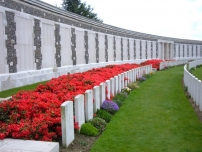| First Name: | Francis William | Last Name: | HOLLAND | |
|---|---|---|---|---|
| Date of Death: | 16/08/1917 | Lived/Born In: | Vauxhall | |
| Rank: | Rifleman | Unit: | King's Royal Rifle Corps12 | |
| Memorial Site: | Tyne Cot Memorial, Belgium | |||
Current Information:Age-18 52, Vauxhall Mansions, South Lambeth Road, Vauxhall
Third Battle of Ypres This was a campaign fought between July and November 1917 and is often referred to as the Battle of Passchendaele, a village to the north-east of Ypres which was finally captured in November. It was an attempt by the British to break out of the Ypres salient and capture the higher ground to the south and the east from which the enemy had been able to dominate the salient. It began well but two important factors weighed against them. First was the weather. The summer of 1917 turned out to be one of the the wettest on record and soon the battlefield was reduced to a morass of mud which made progress very difficult, if not impossible in places. The second was the defensive arrangements of concrete blockhouses and machine gun posts providing inter-locking fire that the Germans had constructed and which were extremely difficult and costly to counter. For 4 months this epic struggle continued by the end of which the salient had been greatly expanded in size but the vital break out had not been achieved. The Battle of Langemarck This took place between 16th-18th August, 1917 and was the second general attack of 3rd Ypres. Although it did not rain during the two days of the battle itself there had been plenty of it in the preceding days and in many places the battlefield was a quagmire. On the left of the attack in the north-west of the Ypres salient there was considerable success, especially for the French Army which attacked on the left of the British, but the attack on the Gheluvelt Plateau, due east of Ypres, met determined German resistance and the early gains were soon reversed. At 4.45am on 16th August, 20th Division attacked in the northern part of the battle front towards the village of Langemarck itself. They used 60 and 61 Brigades for this successful operation and by 7.45am the final objectives had been captured. 60 Brigade attacked on the right with 6th Oxford & Bucks Light Infantry in front and 6th Shropshire Light Infantry and 12th King’s Royal Rifle Corps, following behind. They crossed the Steenbeke, a small stream, after which their movement was restricted to small columns of men winding their way through water filled craters trying to avoid the machine gun fire from the German block houses. One of these caused considerable casualties among all units as they approached the Blue Line and were still some 300-400 yards from Langemarck, but was dealt with by a sergeant from 12th King’s Royal Rifle Corps (Sgt Edward Cooper) in a courageous act that earned him a Victoria Cross. By 7.20 am Langemarck had been captured by 6th Shropshire Light Infantry and 12th King’s Royal Rifle Corps and 25 minutes later they had reached their final objective where they did their best to consolidate their gains. At 4pm, the inevitable German counter attack took place with their efforts concentrated at Schrieboom and the junction of the two brigades of 20th Division. Both 12th King’s Royal Rifle Corps and 12th Liverpool (Kings) of 61 Brigade were driven back about 200 yards but later they rallied and with the assistance of the other battalions they drove the enemy out of the cemetery there. During the hard fighting that had taken place during the day, 12th King’s Royal Rifle Corps had sustained many casualties one of whom was Francis Holland. |
||||
| « Back to Search Results | ||||
| If you think any of the information shown here is incorrect, Click Here to submit your amends and comments | ||||




